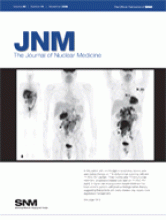About the Cover
Cover image

In this patient with non-Hodgkin's lymphoma, lesions were seen before therapy on 111In-ibritumomab scanning (left) and 18F-FDG PET (center). Three months after 90Y-ibritumomab treatment, progressive disease was seen on 18F-FDG PET (right). A higher rate of progression despite treatment has been noted in patients with positive . ndings before therapy, suggesting that patients with bulky disease may require more aggressive management.
See page 1809.



